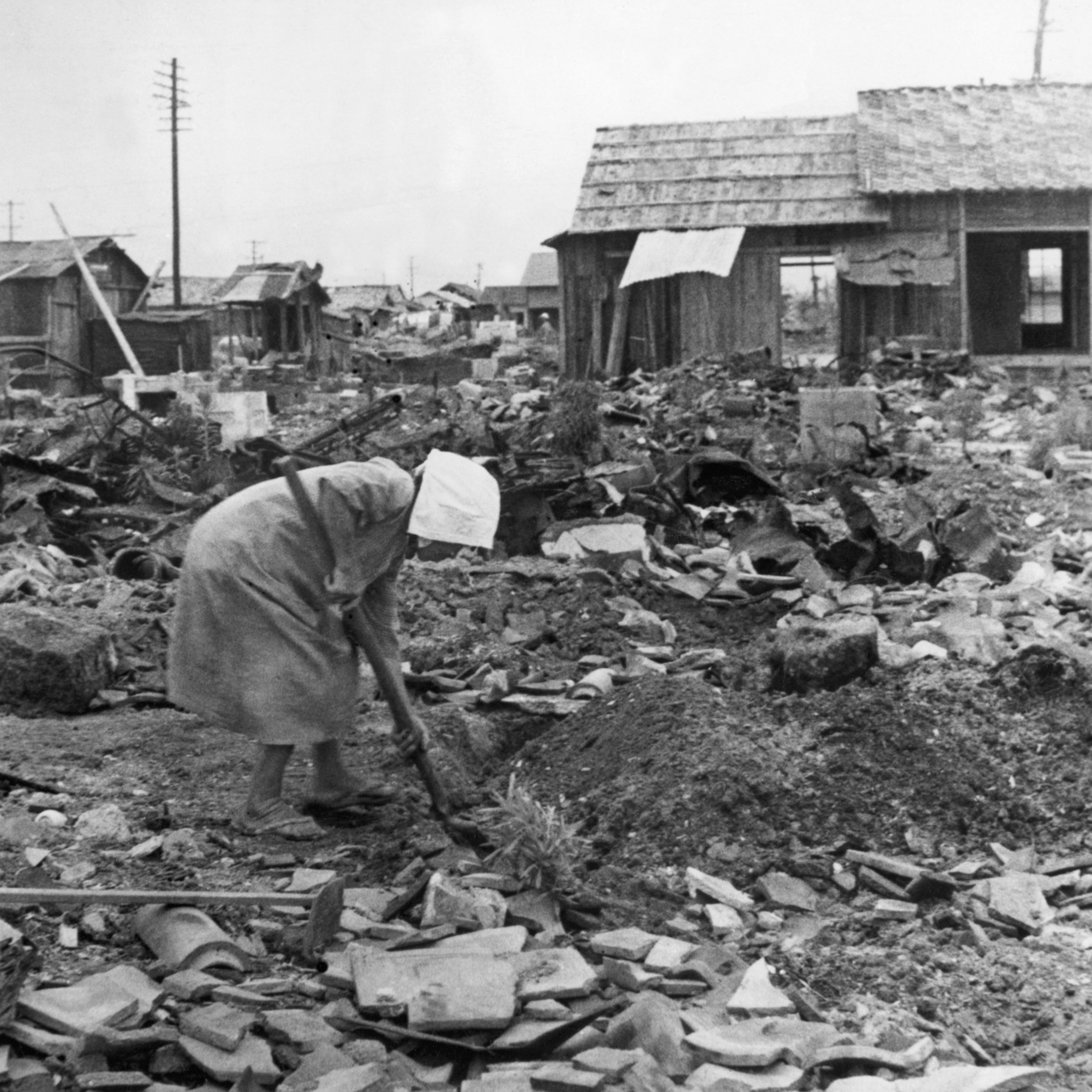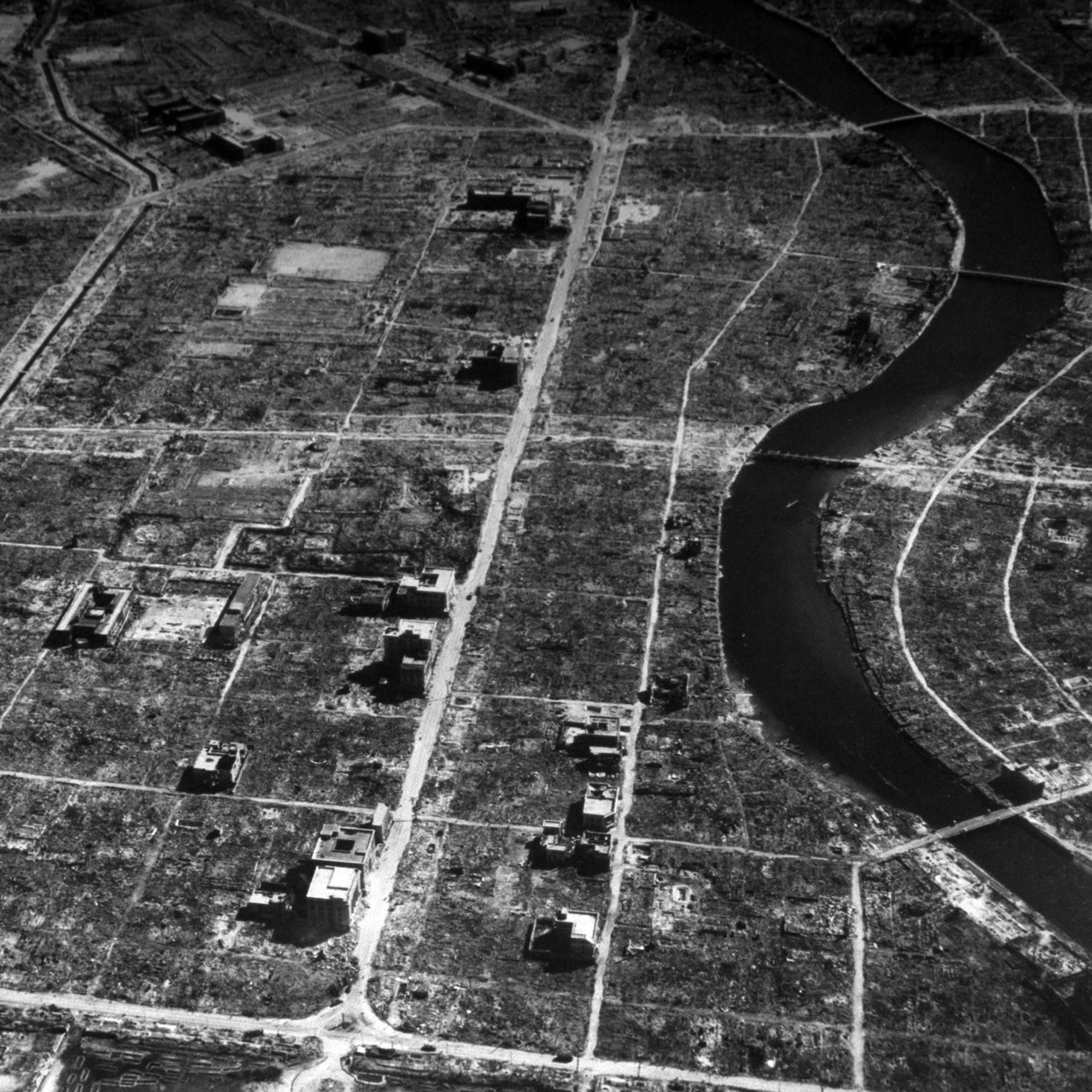Powerful Pictures Show What Nuclear ‘Fire and Fury’ Really Looks Like
72 years after atomic bombs were detonated over Hiroshima and Nagasaki, see the photos taken in the aftermath.
Today’s anniversary of the bombing of Nagasaki arrives in a moment of increasingly heated nuclear rhetoric between the U.S. and North Korea.
These historic pictures show the aftermath of the bombings of Hiroshima and Nagasaki, a black-and-white reminder of what “fire and fury” actually looks like—although the capabilities of modern nuclear weapons far outstrip those of their mid-century counterparts.









As the anniversary of these attacks is marked with prayer, reflection, and ceremony, get a refresher on nuclear weapons, then and now.
1945
At 8:15 a.m. on August 6, 1945, an atomic bomb—codenamed Little Boy—detonated 1,900 feet above Hiroshima, Japan. Though accurate estimates are impossible, it's believed the immediate blast killed about 70,000 people and injured another 70,000. The vast majority of casualties were civilians. After effects, such as complications from radiation exposure, have since taken the lives of unknown thousands more. This event marked the first time a nuclear weapon was used against people in earnest.
At 11:02 a.m. on August 9, a second bomb, called Fat Man, hit Nagasaki, causing another 80,000 casualties. The city’s topography—shielded by a valley and veined with fire-stopping water channels—lessened the bomb’s effects, even though Fat Man’s payload was actually larger than Little Boy’s. Perhaps 160 people survived both blasts, though only one was officially recognized by the Japanese government. (Read the messages Hiroshima survivors gave Obama.)
Japan surrendered days later, officially ending World War II. The U.S.’s top-secret Manhattan Project, spurred into creation after Albert Einstein warned President Franklin Roosevelt of the catastrophic consequences should Nazi scientists develop an atomic bomb first, had been working for four years to create such a weapon.
2017
Today, Hiroshima is inhabited by about 1 million people. A peace memorial park and museum now occupies the site of the bomb’s epicenter; it includes Genbaku Dome, named a World Heritage Site as the only structure in that area to withstand the blast that leveled nearly 70 percent of the city’s buildings and infrastructure. (Millions of people visit Hiroshima every year: learn how the attack is memorialized.)
Nine countries currently hold around 15,000 nuclear weapons, a third of which are in active deployment and can be launched within minutes. Russia’s nuclear arsenal is the largest, although the U.S. spends more on its own arsenal than all other countries combined.
Calls for nuclear regulation, non-proliferation, and disarmament have gone out since the days immediately following the 1945 bombings. Hibakusha, or survivors of atomic bombs, have been a central voice in this effort.
On July 7, the Treaty on the Prohibition of Nuclear Weapons was adopted at a United Nations conference. The ratification process will begin in September; the treaty becomes legally binding when ratified by at least 50 countries. The U.S. and several other countries, including all current nuclear powers and some of their allies, declined to participate in the negotiations.
You May Also Like
Go Further
Animals
- Octopuses have a lot of secrets. Can you guess 8 of them?
- Animals
- Feature
Octopuses have a lot of secrets. Can you guess 8 of them? - This biologist and her rescue dog help protect bears in the AndesThis biologist and her rescue dog help protect bears in the Andes
- An octopus invited this writer into her tank—and her secret worldAn octopus invited this writer into her tank—and her secret world
- Peace-loving bonobos are more aggressive than we thoughtPeace-loving bonobos are more aggressive than we thought
Environment
- This ancient society tried to stop El Niño—with child sacrificeThis ancient society tried to stop El Niño—with child sacrifice
- U.S. plans to clean its drinking water. What does that mean?U.S. plans to clean its drinking water. What does that mean?
- Food systems: supporting the triangle of food security, Video Story
- Paid Content
Food systems: supporting the triangle of food security - Will we ever solve the mystery of the Mima mounds?Will we ever solve the mystery of the Mima mounds?
- Are synthetic diamonds really better for the planet?Are synthetic diamonds really better for the planet?
- This year's cherry blossom peak bloom was a warning signThis year's cherry blossom peak bloom was a warning sign
History & Culture
- Strange clues in a Maya temple reveal a fiery political dramaStrange clues in a Maya temple reveal a fiery political drama
- How technology is revealing secrets in these ancient scrollsHow technology is revealing secrets in these ancient scrolls
- Pilgrimages aren’t just spiritual anymore. They’re a workout.Pilgrimages aren’t just spiritual anymore. They’re a workout.
- This ancient society tried to stop El Niño—with child sacrificeThis ancient society tried to stop El Niño—with child sacrifice
- This ancient cure was just revived in a lab. Does it work?This ancient cure was just revived in a lab. Does it work?
- See how ancient Indigenous artists left their markSee how ancient Indigenous artists left their mark
Science
- This 80-foot-long sea monster was the killer whale of its timeThis 80-foot-long sea monster was the killer whale of its time
- Every 80 years, this star appears in the sky—and it’s almost timeEvery 80 years, this star appears in the sky—and it’s almost time
- How do you create your own ‘Blue Zone’? Here are 6 tipsHow do you create your own ‘Blue Zone’? Here are 6 tips
- Why outdoor adventure is important for women as they ageWhy outdoor adventure is important for women as they age
Travel
- This author tells the story of crypto-trading Mongolian nomadsThis author tells the story of crypto-trading Mongolian nomads
- Slow-roasted meats and fluffy dumplings in the Czech capitalSlow-roasted meats and fluffy dumplings in the Czech capital
- Want to travel like a local? Sleep in a Mongolian yurt or an Amish farmhouseWant to travel like a local? Sleep in a Mongolian yurt or an Amish farmhouse
- Sharing culinary traditions in the orchard-filled highlands of JordanSharing culinary traditions in the orchard-filled highlands of Jordan




